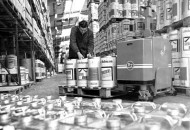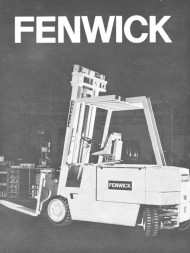 Welcome to episode sixty in our exclusive series on the history of the fork lift truck, the machine which over the decades has revolutionised the face of materials handling around the world. We’re now up to 1974, the year Abba burst into our lives by winning the Eurovision Song Contest for Sweden and in the fork truck industry, rising oil prices sparked an acute shortage of diesel engines and other components.
Welcome to episode sixty in our exclusive series on the history of the fork lift truck, the machine which over the decades has revolutionised the face of materials handling around the world. We’re now up to 1974, the year Abba burst into our lives by winning the Eurovision Song Contest for Sweden and in the fork truck industry, rising oil prices sparked an acute shortage of diesel engines and other components.
Our writer is James Brindley, an acknowledged authority on fork lift trucks. James’s distinguished career has involved engineering and management roles with BT Rolatruc and serving as a Director of the FLTA, before he set up the National Fork Truck Heritage Centre in 2004 as Britain’s first such collection open to the public.
The Heritage Centre continues to need your support in 2011, and if you or your company would like to help in any way, you can contact James on the number below. Now sit back and enjoy the latest part of this fascinating series.
Episode 60: 1974 – Abba win Eurovision; shortages dampen fork lift sales
 In 1974 business was booming, but fork truck manufacturers could not make sufficient equipment quickly enough for industry to take best advantage. Even if they could, the price for the finished item would have been approximately 35% up on the previous year, due to a general demand for steel, tyres and other components. All types of steel could still be obtained, but manufacturers would have to shop around within the European community for the best price and delivery. The situation was also similar for running tyres, in that they were still available for most types of trucks, but at a price that had increased over the previous year by as much as a third.
In 1974 business was booming, but fork truck manufacturers could not make sufficient equipment quickly enough for industry to take best advantage. Even if they could, the price for the finished item would have been approximately 35% up on the previous year, due to a general demand for steel, tyres and other components. All types of steel could still be obtained, but manufacturers would have to shop around within the European community for the best price and delivery. The situation was also similar for running tyres, in that they were still available for most types of trucks, but at a price that had increased over the previous year by as much as a third.
Another area of concern for fork lift manufacturers who produced engine powered trucks was the availability of major components. In this respect there was an acute shortage of diesel engines. As a spokesman for Perkins, one of the leading diesel engine manufacturers, said, “this situation is due to a new and unexpected worldwide demand for diesel engines following the fuel crisis.” The crisis over fuel shortages highlighted the economic superiority of the diesel engine over that of the petrol engine. Although the situation promoted demand, it also caused problems for Perkins in particular, who encountered local labour shortages and the unpredictability from their own suppliers of components in their effort to expand.
For manufacturers with a large range of trucks, the situation did not get any better, as even their battery-powered ranges were affected. The major problem here was the availability and price of batteries. These had also increased over the previous year, by more than 35%. The consequence of the whole situation of component shortage and delay was that deliveries of some of the larger capacity trucks were taking anything up to a year to complete.
Meanwhile, some companies were doing very well out of the situation, especially with the smaller ride-on and pedestrian trucks. Here, in Britain, BT of Sweden launched a sit on powered pallet truck (RSL 2000) and a pedestrian powered pallet truck with a stand on platform (LT 2000).
 Lansing Bagnall also made additions in their pedestrian range, with the POEP 8 and POEP 9 powered pallet trucks. All three of these pedestrian trucks were now fitted with improved safety devices in the control arm heads. Coventry Climax chose this time to announce a new reach truck to add to their range. The R-15, with a lifting capacity of 3,300 lbs, was fitted with their new electronic control unit. This new feature gave an automatic check of the safety circuits and enabled the operator to have electronic control over the hydraulic system. A major benefit of this was that power wastage was reduced. Other features of note were a new design of duplex and triplex masts giving better through-mast visibility and an improved driver cockpit layout.
Lansing Bagnall also made additions in their pedestrian range, with the POEP 8 and POEP 9 powered pallet trucks. All three of these pedestrian trucks were now fitted with improved safety devices in the control arm heads. Coventry Climax chose this time to announce a new reach truck to add to their range. The R-15, with a lifting capacity of 3,300 lbs, was fitted with their new electronic control unit. This new feature gave an automatic check of the safety circuits and enabled the operator to have electronic control over the hydraulic system. A major benefit of this was that power wastage was reduced. Other features of note were a new design of duplex and triplex masts giving better through-mast visibility and an improved driver cockpit layout.
Also introducing new equipment this year was Fenwick with their “Major” series of forklift trucks. These machines were powered by a 72-volt battery, which gave electronic control of the lifting operation, as well as the travelling operation. Lifting capacities of 8,000 lbs, 11,000 lbs and 12,000 lbs were available.
By James Brindley, Director, National Fork Truck Heritage Centre.
To be continued…




Comments are closed.